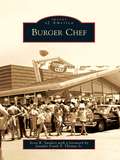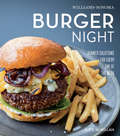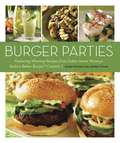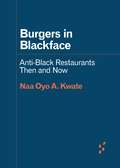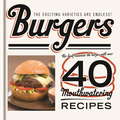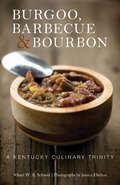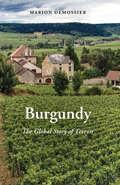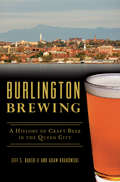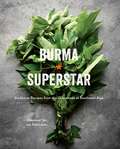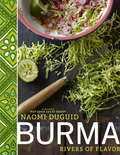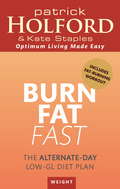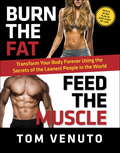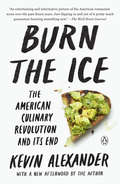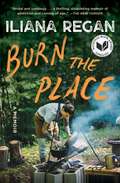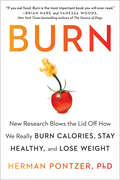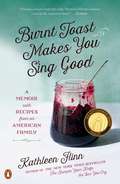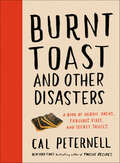- Table View
- List View
Burger Chef
by Scott R. Sanders Frank P. Thomas Jr.Frank P. Thomas Jr., Donald J. Thomas, and Robert E. Wildman, owners of the General Equipment Company, entered into the fast-food business by opening a 15¢ hamburger restaurant called Burger Chef in Indianapolis in 1958. General Equipment was a manufacturer of restaurant machinery and built the equipment installed in each Burger Chef store. The partners started their new Burger Chef division to sell more equipment; they never could have imagined that Burger Chef would eventually grow to become the nation's second-largest hamburger chain and beloved by customers in towns and cities across America. Burger Chef continued in business until 1982, cooking its popular flame-broiled hamburgers and introducing its memorable advertising icons, Burger Chef and Jeff.
Burger Night: Dinner Solutions for Every Day of the Week (Williams-Sonoma)
by Kate McMillanRaise this tried-and-true weeknight staple to a new level with recipes that showcase the burger&’s endless variety of protein and flavor possibilities. A burger is a classic dish, whether it&’s for a Sunday supper or a backyard barbecue. Burger Night is the comprehensive yet easy-to-follow guide to great burgers. There&’s something to please every burger lover: from meaty to vegetarian, classic to creative and simple to elaborate. More than 60 recipes will inspire you to up your bun game, including Gorgonzola-Stuffed Burgers with Grilled Nectarines, Breakfast Burgers, Spiced Lamb Sliders with Romesco Sauce, Crab Burgers with Smashed Avocado, Falafel Burgers with Tahini Cilantro Sauce, and Miso Tofu Burgers with Sauteed Chard & Asian Mayonnaise. Also included are delectable side dishes—from salads to fries—and burger essentials like ketchup, onions, and even vanilla milkshakes.
Burger Parties: Recipes from Sutter Home Winery's Build a Better Burger Contest [A Cookbook]
by James Mcnair Jeffrey StarrEach year, thousands of cooks from coast to coast compete in Sutter Home Winery's Build a Better Burger® Recipe Contest. Ten of these creative home chefs are flown to Napa Valley each September to participate in the BBB Cook-Off, frequently shown on Food Network Challenge. Burger Parties marks the event's 20th anniversary with contest-winning burgers loaded with flavor-enhancing extras and party-ready menus bound to be a hit at any backyard bash. Whether you're in the mood for a Southwest fiesta, New Orleans jazz brunch, tropical patio get-together, or complete festa Italiana, this collection of all-inclusive, themed menus for burger-centric entertaining will delight your palate and your guests. Packed with more than 60 full-color photographs, James McNair and Jeffrey Starr showcase the new frontier in burgers with inventive recipes for Ocean State Swordfish BurgersSmoky-Sweet Bacon BurgersPineapple Upside-Down Jerk BurgersBouillabaisse SlidersSweet-Hot Thai BurgersLittle Italy Sausage BurgersHome on the Range Buffalo Burgers and loads more. Burger Parties features sixteen crowd-pleasing menus with recipes for prize-winning burgers, appetizers, sides, and desserts, plus wine and beverage pairings that are sure to inspire backyard grillers and frequent entertainers with new ways to spice up your gatherings.From the Trade Paperback edition.
Burger Wuss
by M. T. AndersonAnthony has never been able to stand up for himself- that is, not until he finds his girlfriend, Diana, in someone else's arms. Then Anthony vows revenge and devises The Plan. It begins with getting a job at O'Dermott's, the fast-food restaurant where Turner (a.k.a. the guy who stole his girlfriend) happens to be a star employee. It involves one anarchist, one condiment troll, and one '85 Oldsmobile named Margot. But when these ingredients are finally assembled, will The Plan satisfy Anthony's hunger for revenge? And more important, will he ever prove he's not a wuss?
Burgers in Blackface: Anti-Black Restaurants Then and Now (Forerunners: Ideas First)
by Naa KwateExposes and explores the prevalence of racist restaurant branding in the United States Aunt Jemima is the face of pancake mix. Uncle Ben sells rice. Chef Rastus shills for Cream of Wheat. Stereotyped Black faces and bodies have long promoted retail food products that are household names. Much less visible to the public are the numerous restaurants that deploy unapologetically racist logos, themes, and architecture. These marketing concepts, which center nostalgia for a racist past and commemoration of our racist present, reveal the deeply entrenched American investment in anti-blackness. Drawing on wide-ranging sources from the late 1800s to the present, Burgers in Blackface gives a powerful account, and rebuke, of historical and contemporary racism in restaurant branding.Forerunners: Ideas FirstShort books of thought-in-process scholarship, where intense analysis, questioning, and speculation take the lead
Burgers: Burger Coat Of Arms And Family Crest Notebook Journal (6 X 9 - 100 Pages)
by BurgersCould anything be more enjoyable than eating home-cooked burgers surrounded by family and friends?Take a fresh look at burgers with over 40 irresistible recipes that are easy to make and extremely delicious.There is a burger for everyone: Choose from a great selection of meat, poultry, fish, and vegetarian recipes.Burgers have never been so good, and now you can partner them with the perfect homemade sides, sauces, and salads - the perfect accompaniments to everyone's favourite meal.With brilliant novel takes including the Chorizo Burger, the Chicken Caesar Burger and the Jerk Chicken Burger as well as all the classics, this really is the ultimate burger book.
Burgers: Medium Rare
by SpruceCould anything be more enjoyable than eating home-cooked burgers surrounded by family and friends? Take a fresh look at burgers with over 40 irresistible recipes that are easy to make and extremely delicious. There is a burger for everyone: Choose from a great selection of meat, poultry, fish, and vegetarian recipes. Burgers have never been so good, and now you can partner them with the perfect homemade sides, sauces, and salads - the perfect accompaniments to everyone's favourite meal. With brilliant novel takes including the Chorizo Burger, the Chicken Caesar Burger and the Jerk Chicken Burger as well as all the classics, this really is the ultimate burger book.
Burgoo, Barbecue, & Bourbon: A Kentucky Culinary Trinity
by Albert W.A. SchmidThis celebration of the Bluegrass State’s cuisine and culture is “more than just a cookbook . . . a slice of Kentucky's history” (Bowling Green Daily News).Burgoo, barbecue, and bourbon have long been acknowledged as a trinity of good taste in Kentucky. Known as the gumbo of the Bluegrass, burgoo is a savory stew that includes meat—usually smoked—from at least one “bird of the air,” at least one “beast of the field,” and as many vegetables as the cook wants to add. Often you’ll find this dish paired with one of the Commonwealth’s other favorite exports, bourbon, and the state’s distinctive barbecue.Award-winning author and chef Albert W. A. Schmid serves up a feast for readers in Burgoo, Barbecue, and Bourbon, sharing recipes and lore surrounding these storied culinary traditions. He introduces readers to new and forgotten versions of favorite regional dishes from the time of Daniel Boone to today, and uncovers many lost recipes, such as Mush Biscuits and Half Moon Fried Pies. He also highlights classic bourbon drinks that pair well with burgoo and barbecue, including Moon Glow, Bourbaree, and the Hot Tom and Jerry. Featuring cuisine from the early American frontier to the present day, this entertaining book is filled with fascinating tidbits and innovative recipes for the modern cook.
Burgundy
by Robert M ParkerWith the publication of his classic volumes, Bordeaux and The Wire's of the Rhône Valley and Provence, together with the several editions of his Wine Buyer's Guide, Robert M. Parker, Jr., has emerged as America's most influential and articulate authority on wine. Whether he writes of the fabled French châteaux or of lesser-known growers and producers from around the world, his books have proved invaluable reading for connoisseurs and neophytes alike, for they contain not only hard-headed, frank analysis but an undisguised and positively contagious enthusiasm for his subject. In his new book, his most ambitious and comprehensive to date, Parker offers an extraordinary guide to the growers, appellations, and wines of Burgundy, the viticultural region in eastern France that produces the most exotic, sought-after, expensive, and frequently least understood wines in the world. In the introduction, Parker provides an overview of his subject: Where is Burgundy? What sort of climate prevails there and how is it likely to affect the growing season? What varieties of grapes are grown and how are the wines actually made? How are the wines of Burgundy different from those of Bordeaux? Why are they so expensive and frequently so hard to find? He also gives readers a short but incisive history of the Burgundy region, one that explains to a large degree why land holdings there are so fragmented and how, as a result, it is essential for the consumer to know not only where a wine originates (both the appellation and the actual vineyard itself), but who it is that actually makes it. The heart and soul of Burgundy is divided into three separate but interdependent sections. In the first, Parker offers an alphabetical listing of some 640 growers and/or producers of wine. In each entry he catalogs the specific wines produced, discusses their overall quality and style, delineates the vineyard holdings, describes the wine-making techniques employed, and assesses the producer using a one-to-five-star system, with five signifying the very best. In the second section, Parker provides a detailed analysis of the entire Burgundy region, beginning in the northernmost district, Chablis, and descending southward through the famed Côte d'Or (comprised of the Côte de Nuits and the Côte de Beaune), and on to the Côte Chalonnaise, the Mâconnais, and finally, Beaujolais. Covering some thirty-five appellations in all, he offers all the necessary information for the consumer: What is the hierarchy of wines in a given district? What are the Grands Crus and Premiers Crus, for example, in the legendary appellation of Vosne-Romanée? How many acres are under cultivation and with which grape varieties? What are the bench-mark characteristics of a particular wine? Where are the values? What is the aging potential? For the traveling wine enthusiast, he even passes along great tips on restaurants, hotels, and local color, as well as on those vineyards and producers most worth a visit. In the third and final section, Parker sets down vintage summaries for burgundy wines during the years 19451989, noting the effects of the weather on crop size and quality, and describing the basic characteristics of each year's red and white wines. For the years 1983, 1985, 1986, 1987, and 1988, he provides tasting notes and scores based on his 100-point system for dozens of wines from each vintage. Like its predecessors, Bordeaux and The Wines of the RhOne Valley and Provence, Parker's Burgundy has all the makings of a classic. It is a beautifully produced book, and it boasts more than thirty specially made color maps, with those depicting the individual appellations drawn in such exquisite detail that each and every vineyard is visible. Burgundy is a fitting monument to the region that is capable of producing, in Parker's words, "the world's most majestic, glorious, and hedonistic red and white wine."
Burgundy
by Robert M ParkerWith the publication of his classic volumes, Bordeaux and The Wire's of the Rhône Valley and Provence, together with the several editions of his Wine Buyer's Guide, Robert M. Parker, Jr., has emerged as America's most influential and articulate authority on wine. Whether he writes of the fabled French châteaux or of lesser-known growers and producers from around the world, his books have proved invaluable reading for connoisseurs and neophytes alike, for they contain not only hard-headed, frank analysis but an undisguised and positively contagious enthusiasm for his subject. In his new book, his most ambitious and comprehensive to date, Parker offers an extraordinary guide to the growers, appellations, and wines of Burgundy, the viticultural region in eastern France that produces the most exotic, sought-after, expensive, and frequently least understood wines in the world. In the introduction, Parker provides an overview of his subject: Where is Burgundy? What sort of climate prevails there and how is it likely to affect the growing season? What varieties of grapes are grown and how are the wines actually made? How are the wines of Burgundy different from those of Bordeaux? Why are they so expensive and frequently so hard to find? He also gives readers a short but incisive history of the Burgundy region, one that explains to a large degree why land holdings there are so fragmented and how, as a result, it is essential for the consumer to know not only where a wine originates (both the appellation and the actual vineyard itself), but who it is that actually makes it. The heart and soul of Burgundy is divided into three separate but interdependent sections. In the first, Parker offers an alphabetical listing of some 640 growers and/or producers of wine. In each entry he catalogs the specific wines produced, discusses their overall quality and style, delineates the vineyard holdings, describes the wine-making techniques employed, and assesses the producer using a one-to-five-star system, with five signifying the very best. In the second section, Parker provides a detailed analysis of the entire Burgundy region, beginning in the northernmost district, Chablis, and descending southward through the famed Côte d'Or (comprised of the Côte de Nuits and the Côte de Beaune), and on to the Côte Chalonnaise, the Mâconnais, and finally, Beaujolais. Covering some thirty-five appellations in all, he offers all the necessary information for the consumer: What is the hierarchy of wines in a given district? What are the Grands Crus and Premiers Crus, for example, in the legendary appellation of Vosne-Romanée? How many acres are under cultivation and with which grape varieties? What are the bench-mark characteristics of a particular wine? Where are the values? What is the aging potential? For the traveling wine enthusiast, he even passes along great tips on restaurants, hotels, and local color, as well as on those vineyards and producers most worth a visit. In the third and final section, Parker sets down vintage summaries for burgundy wines during the years 19451989, noting the effects of the weather on crop size and quality, and describing the basic characteristics of each year's red and white wines. For the years 1983, 1985, 1986, 1987, and 1988, he provides tasting notes and scores based on his 100-point system for dozens of wines from each vintage. Like its predecessors, Bordeaux and The Wines of the RhOne Valley and Provence, Parker's Burgundy has all the makings of a classic. It is a beautifully produced book, and it boasts more than thirty specially made color maps, with those depicting the individual appellations drawn in such exquisite detail that each and every vineyard is visible. Burgundy is a fitting monument to the region that is capable of producing, in Parker's words, "the world's most majestic, glorious, and hedonistic red and white wine."
Burgundy Stars: A Year in the Life of a Great French Restaurant
by William EchiksonIn many ways, the story that follows is not about cuisine. It is about a country trying to maintain and improve upon its traditions. Above all, it is about an individual pursuing perfection. For a little while, forget high cholesterol and the stress of urban living. Dip in and enjoy the special French joie de vivre. Remember what Bernard insisted I do. Eat and enjoy!
Burgundy: A Comprehensive Guide to the Producers, Appelations, and Wines
by Robert M. Parker Jr.With the publication of his classic volumes, Bordeaux and The Wines of the Rhône Valley and Provence, together with the several editions of his Wine Buyer's Guide, Robert M. Parker, Jr. has emerged as America's most influential and articulate authority on wine. Whether he writes of the fabled French châteaux or of lesser-known growers and producers from around the world, his books have proved invaluable reading for connoisseurs and neophytes alike, for they contain not only hard-headed, frank analysis but an undisguised and positively contagious enthusiasm for his subject. In his new book, his most ambitious and comprehensive to date, Parker offers an extraordinary guide to the growers, appellations, and wines of Burgundy, the viticultural region in eastern France that produces the most exotic, sought-after, expensive, and frequently least understood wines in the world. In the introduction, Parker provides an overview of his subject: Where is Burgundy? What sort of climate prevails there and how is it likely to affect the growing season? What varieties of grapes are grown and how are the wines actually made? How are the wines of Burgundy different from those of Bordeaux? Why are they so expensive and frequently so hard to find? He also gives readers a short but incisive history of the Burgundy region, one that explains to a large degree why land holdings there are so fragmented and how, as a result, it is essential for the consumer to know not only where a wine originates (both the appellation and the actual vineyard itself), but who it is that actually makes it. The heart and soul of Burgundy is divided into three separate but interdependent sections. In the first, Parker offers an alphabetical listing of some 640 growers and/or producers of wine. In each entry he catalogs the specific wines produced, discusses their overall quality and style, delineates the vineyard holdings, describes the wine-making techniques employed, and assesses the producer using a one-to-five-star system, with five signifying the very best. In the second section, Parker provides a detailed analysis of the entire Burgundy region, beginning in the northernmost district, Chablis, and descending southward through the famed Côte d'Or (comprised of the Côte de Nuits and the Côte de Beaune), and on to the Côte Chalonnaise, the Mâconnais, and finally, Beaujolais. Covering some thirty-five appellations in all, he offers all the necessary information for the consumer: What is the hierarchy of wines in a given district? What are the Grands Crus and Premiers Crus, for example, in the legendary appellation of Vosne-Romanée? How many acres are under cultivation and with which grape varieties? What are the bench-mark characteristics of a particular wine? Where are the values? What is the aging potential? For the traveling wine enthusiast, he even passes along great tips on restaurants, hotels, and local color, as well as on those vineyards and producers most worth a visit. In the third and final section, Parker sets down vintage summaries for burgundy wines during the years 1945-1989, noting the effects of the weather on crop size and quality, and describing the basic characteristics of each year's red and white wines. For the years 1983, 1985, 1986, 1987, and 1988, he provides tasting notes and scores based on his 100-point system for dozens of wines from each vintage. Like its predecessors, Bordeaux and The Wines of the Rhone Valley and Provence, Parker's Burgundy has all the makings of a classic.
Burgundy: A Global Anthropology of Place and Taste (New Directions in Anthropology #43)
by Marion DemossierDrawing on more than twenty years of fieldwork, this book explores the professional, social, and cultural world of Burgundy wines, the role of terroir, and its transnational deployment in China, Japan, South Korea, and New Zealand. It demystifies the terroir ideology by providing a unique long-term ethnographic analysis of what lies behind the concept. While the Burgundian model of terroir has gone global by acquiring UNESCO world heritage status, its very legitimacy is now being challenged amongst the vineyards where it first took root.
Burlington Brewing: A History of Craft Beer in the Queen City (American Palate)
by Adam Krakowski Jeff S. Baker IIBurlington has welcomed local farms, breweries and distilleries with open arms. The Queen City fosters a unique culture around beer and farm-to-table cuisine. Daniel Standiford established the city's first brewery in 1880. Prohibition ushered in a dry era that remained for more than a century until Greg and Nancy Noonan fought the law and established Vermont Pub & Brewery in the late 1980s. Since then, breweries have popped up, from nationally recognized Magic Hat down to the city's first blendery, House of Fermentology. Authors Adam Krakowski and Jeff S. Baker II explore Burlington's sudsy history from early newspaper clippings to modern-day tastemakers, along with some delicious recipes.
Burma Superstar: Addictive Recipes from the Crossroads of Southeast Asia
by Kate Leahy Desmond TanFrom the beloved San Francisco restaurant, a mouthwatering collection of recipes, including Fiery Tofu, Garlic Noodles, the legendary Tea Leaf Salad, and many more. Never before have the vivid flavors of Burmese cooking been so achievable for home cooks. Known for its bustling tables, the sizzle of onions and garlic in the wok, and a wait time so legendary that customers start to line up before the doors even open—Burma Superstar is a Bay Area institution, offering diners a taste of the addictively savory and spiced food of Myanmar. With influences from neighboring India and China, as well as Thailand and Laos, Burmese food is a unique blend of flavors, and Burma Superstar includes such stand-out dishes as the iconic Tea Leaf Salad, Chili Lamb, Pork and Pumpkin Stew, Platha (a buttery layered flatbread), Spicy Eggplant, and Mohinga, a fish noodle soup that is arguably Myanmar’s national dish.Each of these nearly 90 recipes has been streamlined for home cooks of all experience levels, and without the need for special equipment or long lists of hard-to-find ingredients. Stunningly photographed, and peppered with essays about the country and its food, this inside look at the world of Burma Superstar presents a seductive glimpse of this jewel of Southeast Asia.
Burma: Rivers of Flavor
by Naomi DuguidThe fact is, some books simply need to exist. Burma: The Cookbook is one of these. Burma is culturally rich and complex in many ways, but perhaps nowhere more than in its extraordinary food culture. It's at the crossroads between the food of the great Indian subcontinent (to its west) and the food of Southeast Asia (to its east), with a dash of Chinese influence (from the north), making it an amazing place in-between. With simple recipes for food that manages to be elegant and earthy at the same time, plus stories of a place and a people that inspired Rudyard Kipling, Somerset Maugham, and George Orwell, this may be Duguid's most enchanting cookbook yet. The book features photographs throughout--of the finished dishes, of people, of a hauntingly beautiful land--as well as travel tips, a history of Burma, extensive glossaries, and a bibliography.
Burma: Rivers of Flavor
by Naomi DuguidWinner, IACP Cookbook Award for Culinary Travel (2013)Naomi Duguid’s heralded cookbooks have always transcended the category to become “something larger and more important” (Los Angeles Times). Each in its own way is “a breakthrough book . . . a major contribution” (The New York Times). And as Burma opens up after a half century of seclusion, who better than Duguid—the esteemed author of Hot Sour Salty Sweet—to introduce the country and its food and flavors to the West.Located at the crossroads between China, India, and the nations of Southeast Asia, Burma has long been a land that absorbed outside influences into its everyday life, from the Buddhist religion to foodstuffs like the potato. In the process, the people of the country now known as Myanmar have developed a rich, complex cuisine that mekes inventive use of easily available ingredients to create exciting flavor combinations.Salads are one of the best entry points into the glories of this cuisine, with sparkling flavors—crispy fried shallots, a squeeze of fresh lime juice, a dash of garlic oil, a pinch of turmeric, some crunchy roast peanuts—balanced with a light hand. The salad tradition is flexible; Burmese cooks transform all kinds of foods into salads, from chicken and roasted eggplant to spinach and tomato. And the enticing Tea-Leaf Salad is a signature dish in central Burma and in the eastern hills that are home to the Shan people.Mohinga, a delicious blend of rice noodles and fish broth, adds up to comfort food at its best. Wherever you go in Burma, you get a slightly different version because, as Duguid explains, each region layers its own touches into the dish.Tasty sauces, chutneys, and relishes—essential elements of Burmese cuisine—will become mainstays in your kitchen, as will a chicken roasted with potatoes, turmeric, and lemongrass; a seafood noodle stir-fry with shrimp and mussels; Shan khaut swei, an astonishing noodle dish made with pea tendrils and pork; a hearty chicken-rice soup seasoned with ginger and soy sauce; and a breathtakingly simple dessert composed of just sticky rice, coconut, and palm sugar.Interspersed throughout the 125 recipes are intriguing tales from the author’s many trips to this fascinating but little-known land. One such captivating essay shows how Burmese women adorn themselves with thanaka, a white paste used to protect and decorate the skin. Buddhism is a central fact of Burmese life: we meet barefoot monks on their morning quest for alms, as well as nuns with shaved heads; and Duguid takes us on tours of Shwedagon, the amazingly grand temple complex on a hill in Rangoon, the former capital. She takes boats up Burma’s huge rivers, highways to places inaccessible by road; spends time in village markets and home kitchens; and takes us to the farthest reaches of the country, along the way introducing us to the fascinating people she encounters on her travels.The best way to learn about an unfamiliar culture is through its food, and in Burma: Rivers of Flavor, readers will be transfixed by the splendors of an ancient and wonderful country, untouched by the outside world for generations, whose simple recipes delight and satisfy and whose people are among the most gracious on earth.
Burn Fat Fast: The alternate-day low-GL diet plan
by Patrick Holford Kate StaplesBurn Fat Fast is quite simply the easiest, healthiest and most effective way to lose weight. Alternate-day dieting, which involves taking in a very low amount of calories on alternate days, is all the rage - this diet takes it to a whole new level. In this book Patrick Holford outlines how, by combining elements of alternate-day fasting with a low glycemic-load (GL) diet, you can lose fat fast, without going hungry or compromising your health. For those new to the low-GL diet it is a way to keep you blood sugar even. Why do this? Because if your blood sugar level resembles a rollercoaster ride you'll have a lot of insulin in your system - and insulin is the fat-storing hormone. In Burn Fat Fast you'll find:* Simple, easy-to-follow guidelines on how the diet works* An outline of what to eat and what to avoid on both phases of the diet* Guidance on fitting the diet into your lifestyle* A short, highly effective fat-burning exercise routine developed by former Gladiator and Olympic athlete Kate StaplesAnd if you need any more encouragement, consider this: as well as encouraging the storage of fat, insulin promotes disease and ageing, so by combining a low-GL diet with alternate-day fasting you will not only lose fat fast but also improve your health and longevity.
Burn the Fat, Feed the Muscle
by Tom VenutoA smart, energizing program to help you shed fat, build muscle, and achieve your ideal body in just 30 days!A huge success as a self-published ebook, Burn the Fat, Feed the Muscle is the bible of fat loss that will allow any reader to get his or her dream body. Tom Venuto has created a program using the secrets of the world's leanest people,although it's not about getting ripped; it is about maximizing your fat loss through nutrient timing and strategic exercise. This totally revised and 25% new book includes a never-before-shared plan that will make it even easier for readers to achieve amazing results.
Burn the Ice: The American Culinary Revolution and Its End
by Kevin Alexander"Inspiring"—Danny Meyer, CEO, Union Square Hospitality Group; Founder, Shake Shack; and author, Setting the TableJames Beard Award-winning food journalist Kevin Alexander traces an exhilarating golden age in American diningOver the past decade, Kevin Alexander saw American dining turned on its head. Starting in 2006, the food world underwent a transformation as the established gatekeepers of American culinary creativity in New York City and the Bay Area were forced to contend with Portland, Oregon. Its new, no-holds-barred, casual fine-dining style became a template for other cities, and a culinary revolution swept across America. Traditional ramen shops opened in Oklahoma City. Craft cocktail speakeasies appeared in Boise. Poke bowls sprung up in Omaha. Entire neighborhoods, like Williamsburg in Brooklyn, and cities like Austin, were suddenly unrecognizable to long-term residents, their names becoming shorthand for the so-called hipster movement. At the same time, new media companies such as Eater and Serious Eats launched to chronicle and cater to this developing scene, transforming nascent star chefs into proper celebrities. Emerging culinary television hosts like Anthony Bourdain inspired a generation to use food as the lens for different cultures. It seemed, for a moment, like a glorious belle epoque of eating and drinking in America. And then it was over.To tell this story, Alexander journeys through the travails and triumphs of a number of key chefs, bartenders, and activists, as well as restaurants and neighborhoods whose fortunes were made during this veritable gold rush--including Gabriel Rucker, an originator of the 2006 Portland restaurant scene; Tom Colicchio of Gramercy Tavern and Top Chef fame; as well as hugely influential figures, such as André Prince Jeffries of Prince's Hot Chicken Shack in Nashville; and Carolina barbecue pitmaster Rodney Scott.He writes with rare energy, telling a distinctly American story, at once timeless and cutting-edge, about unbridled creativity and ravenous ambition. To "burn the ice" means to melt down whatever remains in a kitchen's ice machine at the end of the night. Or, at the bar, to melt the ice if someone has broken a glass in the well. It is both an end and a beginning. It is the firsthand story of a revolution in how Americans eat and drink.
Burn the Place: A Memoir
by Iliana ReganLONGLISTED for the NATIONAL BOOK AWARD A &“blistering yet tender&” (Publishers Weekly) memoir that chronicles one chef&’s journey from foraging on her family&’s Midwestern farm to running her own Michelin-starred restaurant and finding her place in the world.Iliana Regan grew up the youngest of four headstrong girls on a small farm in Indiana. While gathering raspberries as a toddler, Regan learned to only pick the ripe fruit. In the nearby fields, the orange flutes of chanterelle mushrooms beckoned her while they eluded others. Regan&’s profound connection with food and the earth began in childhood, but connecting with people was more difficult. She grew up gay in an intolerant community, was an alcoholic before she turned twenty, and struggled to find her voice as a woman working in an industry dominated by men. But food helped her navigate the world around her—learning to cook in her childhood home, getting her first restaurant job at age fifteen, teaching herself cutting-edge cuisine while hosting an underground supper club, and working her way from front-of-house staff to running her own kitchen. Regan&’s culinary talent is based on instinct, memory, and an almost otherworldly connection to ingredients, and her writing comes from the same place. Raw, filled with startling imagery and told with uncommon emotional power, Burn the Place takes us from Regan&’s childhood farmhouse kitchen to the country&’s most elite restaurants in a galvanizing tale that is entirely original, and unforgettable.
Burn: New Research Blows the Lid Off How We Really Burn Calories, Lose Weight, and Stay Healthy
by Herman PontzerOne of the foremost researchers in human metabolism reveals surprising new science behind food and exercise.We burn 2,000 calories a day. And if we exercise and cut carbs, we'll lose more weight. Right? Wrong. In this paradigm-shifting book, Herman Pontzer reveals for the first time how human metabolism really works so that we can finally manage our weight and improve our health.Pontzer's groundbreaking studies with hunter-gatherer tribes show how exercise doesn't increase our metabolism. Instead, we burn calories within a very narrow range: nearly 3,000 calories per day, no matter our activity level. This was a brilliant evolutionary strategy to survive in times of famine. Now it seems to doom us to obesity. The good news is we can lose weight, but we need to cut calories. Refuting such weight-loss hype as paleo, keto, anti-gluten, anti-grain, and even vegan, Pontzer discusses how all diets succeed or fail: For shedding pounds, a calorie is a calorie.At the same time, we must exercise to keep our body systems and signals functioning optimally, even if it won't make us thinner. Hunter-gatherers like the Hadza move about five hours a day and remain remarkably healthy into old age. But elite athletes can push the body too far, burning calories faster than their bodies can take them in. It may be that the most spectacular athletic feats are the result not just of great training, but of an astonishingly efficient digestive system.Revealing, irreverent, and always entertaining, Pontzer has written a book that will change how you eat, move, and live.
Burnt Toast Makes You Sing Good
by Kathleen FlinnA delicious memoir from the author of The Sharper Your Knife, the Less You Cry In this family history interwoven with recipes, Kathleen Flinn returns readers to the mix of food and memoir beloved by readers of her bestselling The Sharper Your Knife, the Less You Cry. Burnt Toast Makes You Sing Good explores the very beginnings of her love affair with food and its connection to home. It is the story of her midwestern childhood, its memorable home cooks, and the delicious recipes she grew up with. Flinn shares tales of her parents' pizza parlor in San Francisco, where they sold Uncle Clarence's popular oven-fried chicken, as well as recipes for the vats of chili made by her former army cook Grandpa Charles, fluffy Swedish pancakes from Grandma Inez, and cinnamon rolls for birthday breakfasts. Through these dishes, Flinn came to understand how meals can be memories, and how cooking can be a form of communication. Brimming with warmth and wit, this book is sure to appeal to Flinn's many fans as well as readers of Marcus Samuelsson, Ruth Reichl, and Julie Powell.
Burnt Toast Makes You Sing Good
by Kathleen FlinnA delicious memoir from the author of The Sharper Your Knife, the Less You Cry In this family history interwoven with recipes, Kathleen Flinn returns readers to the mix of food and memoir beloved by readers of her bestselling The Sharper YourKnife, the Less You Cry. Burnt Toast Makes You Sing Good explores the very beginnings of her love affair with food and its connection to home. It is the story of her midwestern childhood, its memorable home cooks, and the delicious recipes she grew up with. Flinn shares tales of her parents' pizza parlor in San Francisco, where they sold Uncle Clarence's popular oven-fried chicken, as well as recipes for the vats of chili made by her former army cook Grandpa Charles, fluffy Swedish pancakes from Grandma Inez, and cinnamon rolls for birthday breakfasts. Through these dishes, Flinn came to understand how meals can be memories, and how cooking can be a form of communication. Brimming with warmth and wit, this book is sure to appeal to Flinn's many fans as well as readers of Marcus Samuelsson, Ruth Reichl, and Julie Powell.
Burnt Toast and Other Disasters: A Book of Heroic Hacks, Fabulous Fixes, and Secret Sauces
by Cal PeternellA gifty, funny, and practical guide to transforming the most lackluster of ingredients into a delicious meal, making bad food good and making good food even better, from the author of the New York Times bestselling and IACP Award–winning Twelve Recipes. Dinner is looking meh. Maybe the stove was left unattended for just a second too long for your original plan; maybe the on-sale meat at the supermarket isn’t looking quite worth the savings after two days in the fridge. Do you waste food and time trying to start from scratch, or money ordering takeout? No, you face up to the facts, step up your game, and transform that cooking conundrum into a delicious meal. The best way to do that? Follow the guidance of Cal Peternell, a chef coming out of the restaurant kitchen to meet cooks where they are with this funny, practical manual for making Bad Food Good. Though many pro chefs may be able to get their sustainably sourced, locally grown, 100 percent grass-fed, organic ingredients and gently guide them through careful preparation to a simply sublime dish, most of us don’t achieve farm-to-table perfection in every step of the process. From facing down third-day leftovers that have lost a little of their luster to the limits of their local supermarket’s quality, many home cooks start at a disadvantage. With his signature dry wit and years of experience cooking for everyone from high-end restaurant patrons to his hungry family, Cal Peternell is here to level the playing field with this bag of tricks for turning standard (or substandard) fare into a meal to be proud of, troubleshooting such situations as: Making the best of burned food (Burned your toast? Time to make Cheesy Onion Bread Pudding!) Hacking packaged food (including 5 variations on “Hackaroni and Cheese”) Things restaurants often do wrong and you can do better (including pesto, queso, bean dip, ranch, and more) Spicing up lackluster vegetables (Brocco Tacos dazzle both in name and in flavor) Snazzing up dishes with “special sauces for the boring” (including vegetable purees and an infinite variety of savory butter sauces) Cal also includes a series of hilarious Old Man cocktails, ranging from the Bitter Old Man (one part bitter, one part brandy) to the Wise Old Man (8 ounces water and a good night’s sleep). Up your cooking game by learning how to spin anything in your pantry or fridge into something special with Burnt Toast and Other Disasters.
